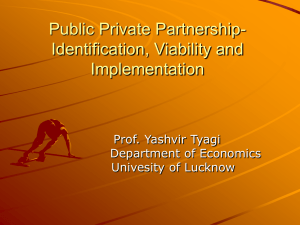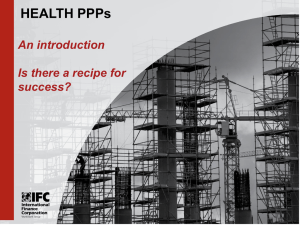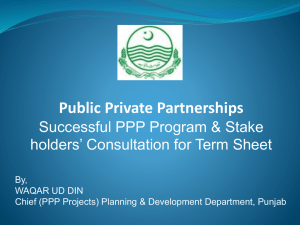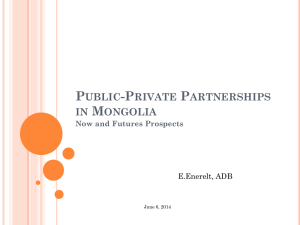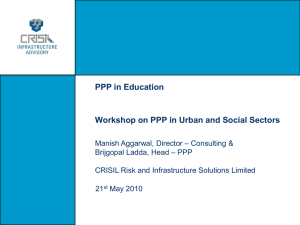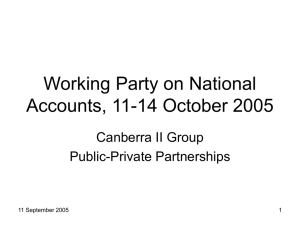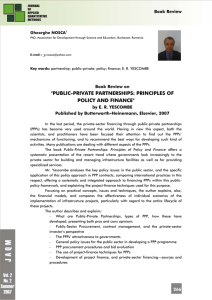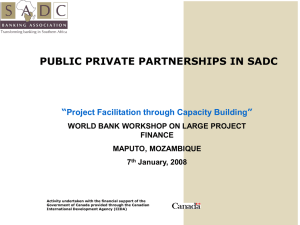Jason Jolley Presentation
advertisement
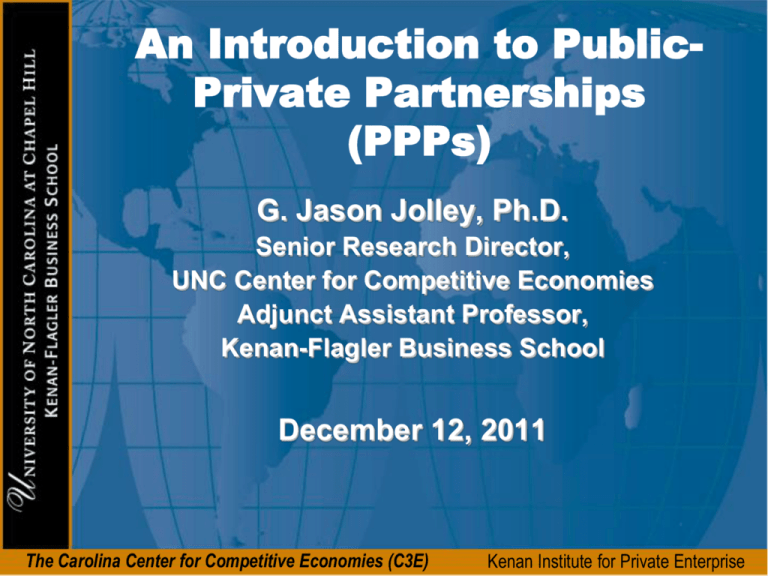
An Introduction to PublicPrivate Partnerships (PPPs) G. Jason Jolley, Ph.D. Senior Research Director, UNC Center for Competitive Economies Adjunct Assistant Professor, Kenan-Flagler Business School December 12, 2011 The Carolina Center for Competitive Economies (C3E) Kenan Institute for Private Enterprise Overview What are PPPs? PPP Structures Mega-Projects Successful examples Public-Private Partnerships Long-term contract between public and private sector where private sector performs service delivery Payments made over life of contract to private sector (by public sector or users) Design, construction, financing, and operation of public infrastructure by private sector Benefits PPPs leverage of public dollars with private capital to finance and/or deliver service May shift cost burden away from general taxes on public to specific user fees for those receiving benefit Example: public funded freeway vs. privately financed toll road Typical Public Sector Project Design-Bid-Build typical public sector procurement Public sector funds full costs, including overruns Public sector specifies design or bids design and then bids for construction based on design How is PPP different? Public sector specifies desired “outputs” or public service the facility will provide Private sector design-finance-build-operate facility to meet those public service needs Private sector receives payments over life of PPP contract to repay financing costs and yield returns to investors Shifts risk from public authority to private sector (i.e. project company). Common PPP Models Design Build : private sector responsible for design and construction at fixed price; cost overruns risk transferred Operation-Maintenance: Private sector responsible for operation and maintenance. Public retain ownership. Design-Build-Finance-Operate: private sector owns project and controls service delivery for fixed period of time (~25 years) before transferring asset back to public sector Build-Own-Operate: private sector retains ownership of asset in perpetuity, but gov. purchases services for fixed length of time. Project Finance Project finance key to understanding PPPs Highly leveraged, nonrecourse debt Lending occurs against cash-flow generated by project • Concession allows private sector to collect user fees SPV (special purpose vehicle) created with no liability beyond project or recourse to sponsor Project Finance for Road Concession Project company owned by private investors Financed through shareholder equity and projectfinance debt Concession agreement with public authority. Allows for collection of tolls from road users, but does not usually involve payment by or to public authority Cash flow after operating expenses (operating and maintenance contracts) goes first to debt service and then to investors. Subcontracts: Road Concession Design and build contract—contractor agrees to design and construct the completed road and related works (toll booths) to required specs at fixed schedule and price Operating contract—toll operation company provides services such as manning toll booths, minor repairs, accident management Maintenance contract—maintenance company provides road maintenance services Risks Construction period Technological risk Environmental risk Operation period Market risk (price fluctuations) Political risk Technological Risk Project may be unique and not easily replicated in other places Engineering and design failures Lead to delays in construction and cost escalation Environmental Risks Adverse environmental impacts and hazards Delay project and lead to cost escalation Require costly mitigation Discover of important archaeology or fossils on site Market Risk General operating risks related to higher operating costs or maintenance costs than projected Due to price fluctuations or miscalculation Revenue risks with volatility in price and demand Change in interest rates or inflation Political Risk Projects in emerging markets have higher premiums on borrowers due to political risks Involvement of multilateral development banks (MDBs) or export credit agencies mitigates this risk MDBs are “institutions that provide financial support and professional advice for economic and social development activities in developing countries” (World Bank) Typically World Bank Group and its regional development banks. Change in laws or leadership change Risk Management Strategies Risks retained by public authority/government Risks transferred to and retained by project company Risk transferred to project company, which tries to reallocate to subcontractors, use insurance, or sponsor guarantees Risk transferred to end users in concession agreement by having right to impose higher fees Principles of Risk Transfer Maximize VfM (Value for Money). Transfer risk to those best able to control them at the lowest cost Public authority/gov retains risk private sector cannot contain cost effectively Those that retains risks should benefit from upside as well. Concessions in Transportation In concession model, usage risk usually taken by project company Yescombe, a British project finance expert, estimates 10% of road concessions are financial failures (Flyvberg—has worse estimates). Road failures Too optimistic view of traffic forecasts Difficult valuing time saved by drivers Lower use by higher tolled vehicles like trucks Slower than projected growth in traffic Competing connecting roads not considered in projections Usage Risks In models where public authority pays service fee based on availability for use, then usage risks may occur Example: contract to pay to use a school facility, but it is no longer in demand due to population changes. Contract to use hospital, but changes in medical procedures render set-up obsolete. Mega-Projects Large infrastructure projects costing >$500 Million Cost requires PPP structures and complex contracting. Many have high failure rates Why Mega-Projects Fail Large cost overruns 44.7% for rail 33.8% for bridges/tunnels 20.4% for roads In accuracy of travel forecasts -51.4% for rail 9.5% for road Why do these project fail? Technical (inadequate data and models) Psychological (optimism bias) Political-economic (strategic misrepresentation) Technical Honest mistakes Lack of experienced forecasters Unreliable/outdated data In appropriate models Largely rejected as a major cause Psychological Explanation where political and organization pressure is low Optimism bias Cognitive biases in how humans process information Involuntarily spin scenarios of success and overlook potential for mistakes Political-economic strategies Planners and promoters deliberately overstate benefits and underestimate costs Doing so increases likelihood of funding, while honest assessments decrease likelihood. Competition for scarce resources Especially prone when there is high political or organizational pressure Machiavelli’s Formula Underestimate costs + Overestimated revenues + Undervalued environmental impacts + Overvalued development effects = Project approval! Inverted Darwinism. Survival of the un-fittest. Reference Class Forecasting (RCF) Identify reference class of past projects Establish probability distribution Compare project relative to the class Commonly results in higher expected costs and risks of cost overrun. Provides an “outside” view of risks. Bent Flyvbjerg Successful PPPs Chesapeake Forest Union Station Alameda Corridor Chesapeake Forest Eastern Shore divested forestry holdings in eastern shore of Chesapeake Bay. Maryland lacked funds to purchase and manage lands. Jobs at stake. PPP purchased and managed land. Public sector monitors environmental practices and PPP managers forest in sustainable way. Timber harvest income makes project economically self-sustained. Generates revenue for local/state gov Contributes to water quality improvements in bay and keeps land out of non-forested uses Union Station, Washington D.C. 1981 Union Station in disrepair, unoccupied, and in danger of demolition USDOT took control of project and entered PPP for restoration USDOT, D.C. city gov. ($40M), Amtrak ($70M), and a private developer ($50M equity financing). $160M, 5 year project. Reintroduced train and urban mass transit in addition to retail, dining and entertainment. Private developer pays base rent indexed for inflation and profits from operation are shared with private developer and Redevelopment corporation. Amtrak funds repaid by station revenue. Alameda Corridor 20 mile express freight rail line that links the ports of Los Angeles and Long Beach to the national rail network in Los Angeles. Goal of reducing congestion and promoting economic development ½ public; ½ private funds. Estimated cost of $1.8B, actual cost of $2.4B. Yet, usage has allowed loan to be paid off 28 years ahead of schedule

